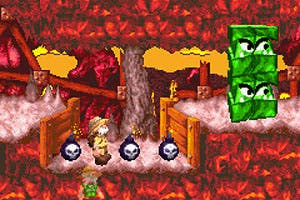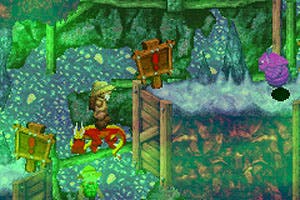Sabre Wulf
Rare seeks inspiration from its past for a return to form...
20 years ago there was only one game developer you could really trust. Going by the justifiably arrogant and typically long-winded Ultimate Play The Game, this Ashby-De-La-Zouch based company had - in just over 12 months - churned out six bona fide classics on the Sinclair Spectrum. Cookie, Pssst!, Trans Am, Jet Pac for the humble 16k version, and Lunar Jetman and Atic Atac for the 48k.
These games, retailing at a mere £5.95, had set the bar for British game development, and had all been huge critical and commercial hits for the enigmatic company, also known as Ashby Computer Graphics. In the early summer of 1984 it had just finished the format's first isometric 3D title - Knight Lore - starring an adventurous character by the name of Sabre Man. But in this bewildering era of fast progression, Ultimate held it back, not wanting to play its hand too soon.
The war against terror

Instead it upped the price to £9.95, put the game in a lavish black box and released another Sabre Man title - Sabre Wulf. Like a bloated jungle-based version of the still-brilliant-today Atic Atac, this vast 256-room epic took action-adventure exploration gameplay into uncharted territory. Featuring the Khaki-clad, sword-wielding imperialist Sabre Man, you were tasked with retrieving the shattered remains of an amulet which would put an end to the reign of terror of the dreaded Wulf.
With just five lives to play with, you wandered around collecting booty, fended off deadly respawning enemy and took in the sights, which - at the time - had you bellowing excitedly "look at the graphics!" to all your fellow rubber key Speccy owning mates over a well thumbed copy of Crash! The truth is, it was easy to be impressed back then, and Sabre Wulf was actually one of the first Ultimate games to dispense with its glorious pick-up-and-play formula. With its one-touch-and-you're-dead gameplay, and literally a maze of rooms, it was fantastically difficult - even in those bloody-minded times. But it was nevertheless a fantastic technical achievement that endeared by being so vast and so pretty, and - like most other Ultimate titles - it spawned endless exploration-based clones.
With our history lesson over, we can fast forward to the present and welcome back Sabre Man after an absence of nearly two decades. Only this time, this isn't the freeform exploration romp that thirty-somethings will recall, but a focused, superbly designed platform game that takes Rare's Donkey Kong Country graphics and applies them to its own long dormant franchise. Removing the rose tinted spectacles, it was obvious that Rare couldn't get away with just reviving the redundant unplayability of old, and instead it has come up with one of the few handheld games we've seen lately that is a) not licence-based, b) isn't a port of an existing title and c) is a fresh take on a stale genre.
Stupidly named baddie alert

The premise is simple. The evil Dr Doolittle Goode has released Sabre Wulf from his long-term imprisonment, and you must work your way through eight increasingly difficult areas in order to reclaim the Amulet and thwart Goode's nefarious plan. In reality this involves wandering around an isometric 3D environment, chatting to its inhabitants and performing a daring raid on each of Sabre Wulf's lairs.
Entering each area switches to a familiar side-scrolling viewpoint, and the game then becomes something of a 'platform title with a difference'. Being long in the tooth, Sabre Man hasn't quite got the physical prowess he once had, and although he can't fight, he can call upon the help of a posse of 'Good Creatures' in order to defeat the various 'Bad Creatures' that block the path to Sabre Wulf and whatever ill-gotten booty he's guarding.
For example, the sleeping Blubba bear makes for a great trampoline to bounce over obstacles, or reach higher platforms, while the explosive Boomer can blow up almost anything. Better still, the Clubber or Big Foot can be set on their way to smash or stomp their way past most of what's in their path, and the game quickly tools you up with more of these Good Creatures, but simultaneously throws an ever increasing number of Bad ones in your path.
The need for speed

This Paper, Scissors, Stone gameplay formula then gives way to a simple chase sequence where you must guide Sabre Man safely back to his tent, with the rabid Sabre Wulf in hot pursuit. Touch him and the game puts you back to the start of the chase - rather than forcing you to do the entire level from scratch - and then rewards you with a Gold, Silver or Bronze medal, depending on how many coins you've rounded up. You can later trade in your treasure and medals at Cookie's shop for new Good Creatures, which become permanent additions to your inventory and give you a better chance of progressing. If you feel like improving on your medal status, the game keeps each level open for replay, and even times your performance into the bargain.
The first few hours of play, though, seem worryingly simplistic. Most levels can be conquered within minutes and for the first 30 per cent or so, reaching Sabre Wulf and certain victory doesn't pose too much of a problem. Even so, the exceptionally well-designed visuals add a gloss rarely seen in GBA titles, and nostalgists will be wallowing in the dozens of Ultimate references sprinkled throughout the game. Not only do the place names reference old favourites (Blackwyche, Karnath, Underwurlde, Entombed, Knightlore, Nightshade, Imhotep, Dragonskulle), but even the odd character from the past makes an appearance (Cookie), as well as some of the lavish cover art (witness the Atic Atac mat near the beginning). Even if you don't get the references, there's still plenty to admire in the game design, the neat animation touches and the quality of the environments generally, and eventually there's a head-scratching challenge to overcome too.
Taking a step back into old territory has given Rare the chance to focus on the basic principles of solid gameplay, with a smooth learning curve and a refined feel that hooks instantly and keeps you coming back for more. Some might find it a little twee, or just too simplistic to commend, but for a handheld title it has that perfect bite-sized sensibility that guarantees you enough gameplay to fit any period of dead time that you might have on your hands.
Wulf it down
It's surprising that more hasn't been made of Sabre Wulf's arrival to the GBA. It's possible that the name just doesn't inspire any interest in its target market (not that the lack of marketing behind the title has exactly helped), and old timers rarely justify buying something on the GBA unless it's something they're familiar with. It's not often that original GBA titles inspire the feel good factor of Sabre Wulf. It has an uncanny knack of holding your interest, rarely feels frustrating, and deserves to be heralded among the very best titles on the format. Whether you'll feel too happy shelling out full price for a game as simple as this is another matter, but on the basis of quality alone, it's right up there.

